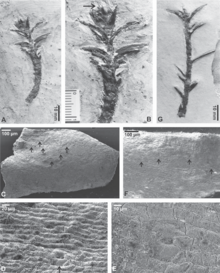Cheirolepidiaceae
| Cheirolepidiaceae Temporal range:
| |
|---|---|

| |
| Leafy shoot of Tomaxellia showing details of epidermis and stomata | |
| Scientific classification | |
| Kingdom: | Plantae |
| Clade: | Tracheophytes |
| Clade: | Gymnospermae |
| Division: | Pinophyta |
| Class: | Pinopsida |
| Order: | Pinales |
| Family: | †Cheirolepidiaceae Turutanova-Ketova 1963 |
| Genera | |
| |
| Synonyms | |
| |
Cheirolepidiaceae (also spelled Cheirolepidaceae) is an extinct

The habit of cheirolepidaceous confers is likely to have varied widely, from large trees (some with trunks over 3 metres (9.8 ft) thick at their base) to shrubs.[3][4] Their architecture is poorly known, though some are thought to have had decurrent spreading crowns, while others had conical crowns. Many seem to have plagiotropic lateral branches that developed in whorls.[4]
The relationships of Cheirolepidiaceae to other conifers are uncertain. A close relationship with Araucariaceae and Podocarpaceae has been proposed, based on the similarities of their reproductive structures,[5] though other studies have suggested that they may fall outisde the crown group of modern conifers among various voltzialean lineages.[6]
At least some species of Cheirolepidiaceae have been suggested to have been pollinated by insects, due to the construction of the reproductive organs and the fact that insects have been found associated with Classopolis pollen grains.[7][8]
The family name Hirmeriellaceae is a junior synonym of Cheirolepidiaceae.[9] Some authors have suggested Hirmeriellaceae is the valid name for the family, due to nomenclatural issues with the original Cheirolepis genus, which is a junior homonym of a member of Asteraceae, with Cheirolepidium suggested to be an invalid replacement. Both genera are likely synonyms of Hirmeriella.[10]
Genera
- †Agathoxylon (wood, in part)
- †Brachyoxylon (wood)
- †Classopollis(pollen)
- †Classostrobus (pollen cones)
- †Dicheiropollis (pollen)
- †Frenelopsis (foliage)
- †Hirmeriella (whole plant)
- †Pararaucaria (ovulate cones)
- †Pseudofrenelopsis (foliage)
- †Watsoniocladus (foliage)
- †Brachyphyllum (foliage, in part)
- †Tomaxiella (foliage and ovulate cone)
- †Kachaikestrobus (ovulate cones)
- †Alvinia (ovulate cones)
- †Pseudohirmeriella (ovulate cones)
References
